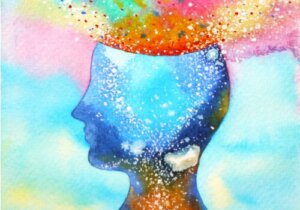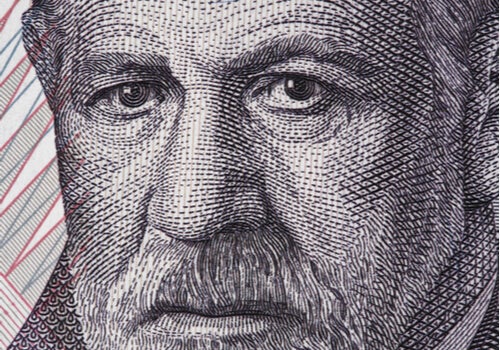Psychoanalysis and Art: A Link to the Unconscious

Psychoanalysis has been strongly related to art ever since it started. Because of that, we can talk about psychoanalysis and art as two closely-related disciplines.
Sigmund Freud was the creator of psychoanalysis. It’s a philosophy, therapeutic practice, and research base that focuses on the study and responses of human beings, especially in relation to unconscious aspects. However, Freud mentioned art in his research on several occasions and even considered it a mobilizer against anguish.
Certainly, the link of the unconscious with art has been widely recognized. In this article, we’ll go beyond that and talk about the relationship between these two disciplines.
Psychoanalysis and art: the times of Freud
Freud had a very close relationship with art. In fact, he spent hours in museums analyzing different works. He enjoyed, and was attracted to, many different types of art, and even collected pieces of sculpture. In addition, in some of his letters, he confessed his admiration for certain authors, such as Cervantes.
From his admiration for literary and mythological works were born some of his analyses that he would later bring together in his books. For example, The Oedipus Complex, The Poet and Fantasy, Dostoevsky and Parricide, and a childhood memory of Leonardo Da Vinci, among others.
Freud has left us an important legacy, and this is evidence of the link between psychoanalysis and art. Let’s see his contributions:
- Questioning artistic, mythological, and cultural origins.
- Analysis of the relationship between the creator and his work.
- The effect of the work of art on the observer.
- The artist’s intention.
- Concept of sublimation.

In addition to that, he considered the artist a person with the capacity to transform their instincts into reality through their artwork. And, as well as that, to turn those impulses into something aesthetic, that is, socially acceptable.
On the other hand, Freud suggested that the artist and the analyst were also closely related, since both of them work on the same object, albeit via a different method. The psychoanalyst through analysis, and the artist through their creations.
From anxiety to creativity
As he immersed himself in studying art, Freud came to shape the concept of sublimation. This is a defense mechanism that would allow a person to change their sexual impulses for higher and more socially valuable ones.
In other words, art would be a way of following our impulses through a vehicle that society does accept. Future authors of psychoanalysis have also continued to emphasize this kind of transformation in our unconscious impulses and mechanisms.
In fact, various psychoanalysts have begun to establish that art is a kind of vehicle, as it facilitates mobilization. They’re particularly referring to anguish, and art can be a way of transforming suffering.
Later on, it was established that art is a way of managing the void. The void would become the impulses we have, and art a way of containing them. From here, we would then transform the anguish, impulses, and other unconscious mechanisms into art.
This way, we turn what we carry inside into something that’s more digestible, both for us and for others. Thus, we mobilize what we feel and transform it into art.
Psychoanalytic therapy and art
Psychoanalysis proposes that when a person has a mental disorder, art can be of help to them. This occurs because the person is able to establish the first links with what’s inside of them. As a result, they’ll be able to better understand what’s happening to them.
Psychoanalysis has regarded creativity as a form of relief, and as a type of alcohol to clean wounds. It can truly be a therapeutic complement of incalculable value due to the absence of restrictions.
There are even several psychoanalysts who use art as a therapeutic tool during their sessions. For example, Bayro Corrochano, in an article for the CES Psychology magazine, tells the story of a boy who used clay to express himself during the sessions. In this way, he gradually established links with reality through his analysis and the child’s own creations.

Psychoanalysts in art
Several psychoanalysts have linked themselves with art in some way. Let’s look at some of them:
- Otto Rank. He proposed that art is a way to overcome distress.
- Donald Winnicott. He saw art as a means of finding meaning in what we do, and to give it meaning.
- Melanie Klein. She suggested art as a means of reorganizing the structure of the mind.
- Wilfred Bion. He also said that art could be a way of containing distress.
- Jacques Lacan. He suggested that art is a way of organizing and calming the emptiness we feel. He was referring to a form of communication that would connect directly with the unconscious.
Psychoanalysis and art are two disciplines that are intimately related. Both have to do with the human psyche, and can bring out our deepest aspects. Thanks to this link, experts have continued to explore art as an alternative to help people from a psychological perspective. It’s a way of using a blank canvas to understand and use people’s personal suffering with a view to finding healing.
Psychoanalysis has been strongly related to art ever since it started. Because of that, we can talk about psychoanalysis and art as two closely-related disciplines.
Sigmund Freud was the creator of psychoanalysis. It’s a philosophy, therapeutic practice, and research base that focuses on the study and responses of human beings, especially in relation to unconscious aspects. However, Freud mentioned art in his research on several occasions and even considered it a mobilizer against anguish.
Certainly, the link of the unconscious with art has been widely recognized. In this article, we’ll go beyond that and talk about the relationship between these two disciplines.
Psychoanalysis and art: the times of Freud
Freud had a very close relationship with art. In fact, he spent hours in museums analyzing different works. He enjoyed, and was attracted to, many different types of art, and even collected pieces of sculpture. In addition, in some of his letters, he confessed his admiration for certain authors, such as Cervantes.
From his admiration for literary and mythological works were born some of his analyses that he would later bring together in his books. For example, The Oedipus Complex, The Poet and Fantasy, Dostoevsky and Parricide, and a childhood memory of Leonardo Da Vinci, among others.
Freud has left us an important legacy, and this is evidence of the link between psychoanalysis and art. Let’s see his contributions:
- Questioning artistic, mythological, and cultural origins.
- Analysis of the relationship between the creator and his work.
- The effect of the work of art on the observer.
- The artist’s intention.
- Concept of sublimation.

In addition to that, he considered the artist a person with the capacity to transform their instincts into reality through their artwork. And, as well as that, to turn those impulses into something aesthetic, that is, socially acceptable.
On the other hand, Freud suggested that the artist and the analyst were also closely related, since both of them work on the same object, albeit via a different method. The psychoanalyst through analysis, and the artist through their creations.
From anxiety to creativity
As he immersed himself in studying art, Freud came to shape the concept of sublimation. This is a defense mechanism that would allow a person to change their sexual impulses for higher and more socially valuable ones.
In other words, art would be a way of following our impulses through a vehicle that society does accept. Future authors of psychoanalysis have also continued to emphasize this kind of transformation in our unconscious impulses and mechanisms.
In fact, various psychoanalysts have begun to establish that art is a kind of vehicle, as it facilitates mobilization. They’re particularly referring to anguish, and art can be a way of transforming suffering.
Later on, it was established that art is a way of managing the void. The void would become the impulses we have, and art a way of containing them. From here, we would then transform the anguish, impulses, and other unconscious mechanisms into art.
This way, we turn what we carry inside into something that’s more digestible, both for us and for others. Thus, we mobilize what we feel and transform it into art.
Psychoanalytic therapy and art
Psychoanalysis proposes that when a person has a mental disorder, art can be of help to them. This occurs because the person is able to establish the first links with what’s inside of them. As a result, they’ll be able to better understand what’s happening to them.
Psychoanalysis has regarded creativity as a form of relief, and as a type of alcohol to clean wounds. It can truly be a therapeutic complement of incalculable value due to the absence of restrictions.
There are even several psychoanalysts who use art as a therapeutic tool during their sessions. For example, Bayro Corrochano, in an article for the CES Psychology magazine, tells the story of a boy who used clay to express himself during the sessions. In this way, he gradually established links with reality through his analysis and the child’s own creations.

Psychoanalysts in art
Several psychoanalysts have linked themselves with art in some way. Let’s look at some of them:
- Otto Rank. He proposed that art is a way to overcome distress.
- Donald Winnicott. He saw art as a means of finding meaning in what we do, and to give it meaning.
- Melanie Klein. She suggested art as a means of reorganizing the structure of the mind.
- Wilfred Bion. He also said that art could be a way of containing distress.
- Jacques Lacan. He suggested that art is a way of organizing and calming the emptiness we feel. He was referring to a form of communication that would connect directly with the unconscious.
Psychoanalysis and art are two disciplines that are intimately related. Both have to do with the human psyche, and can bring out our deepest aspects. Thanks to this link, experts have continued to explore art as an alternative to help people from a psychological perspective. It’s a way of using a blank canvas to understand and use people’s personal suffering with a view to finding healing.
All cited sources were thoroughly reviewed by our team to ensure their quality, reliability, currency, and validity. The bibliography of this article was considered reliable and of academic or scientific accuracy.
- Bayro-Corrochano, F. (2012). Reinventamos un niño a través de la forma tridimencional: Roberto con la Gorra. Revista Ces Psicología 5 (1), pp. 102-111.
- Castro, M.A (2015). Psicosis, psicoanálisis y arte.
- Freud, S. (1982). Saggi sull arte, la letteratura e il linguaggio (4a ed.). Torino: Boringhieri.
This text is provided for informational purposes only and does not replace consultation with a professional. If in doubt, consult your specialist.







